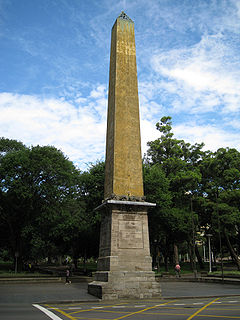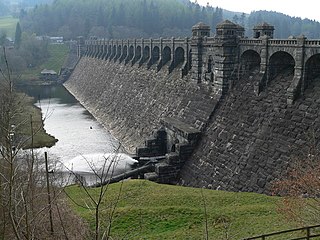Related Research Articles
Subterranean London refers to a number of subterranean structures that lie beneath London. The city has been occupied by humans for two millennia. Over time, the capital has acquired a vast number of these structures and spaces, often as a result of war and conflict.

The Water Services Regulation Authority, or Ofwat, is the body responsible for economic regulation of the privatised water and sewerage industry in England and Wales. Ofwat's main statutory duties include protecting the interests of consumers, securing the long-term resilience of water supply and wastewater systems, and ensuring that companies carry out their functions and are able to finance them.

Sir Joseph William Bazalgette CB was a 19th-century English civil engineer. As chief engineer of London's Metropolitan Board of Works, his major achievement was the creation of a sewerage system for central London which was instrumental in relieving the city from cholera epidemics, while beginning to clean the River Thames. He was also the designer of Hammersmith Bridge.

The London sewer system is part of the water infrastructure serving London, England. The modern system was developed during the late 19th century, and as London has grown the system has been expanded. It is currently owned and operated by Thames Water and serves almost all of Greater London.
Sewage disposal regulation and administration describes the governance of sewage treatment and disposal.

The Thames Tideway Tunnel is a 25 km (16 mi) combined sewer under construction running mostly under the tidal section (estuary) of the River Thames across Inner London to capture, store and convey almost all the raw sewage and rainwater that currently overflows into the estuary. These events occur when rainfall volumes exceed the capacity of Bazalgette's and other engineers' London sewerage system.

Anglian Water is a water company that operates in the East of England. Anglian Water is regulated under the United Kingdom Water Industry Act 1991. It came into existence in 1989 as part of the partial privatisation of the water industry. It took on the water supply, sewerage and sewage treatment responsibilities of Anglian Water Authority. The remaining functions of the authority transferred to the newly formed Environment Agency.

Thames Water Utilities Ltd, known as Thames Water, is a large private utility company responsible for the public water supply and waste water treatment in most of Greater London, Luton, the Thames Valley, Surrey, Gloucestershire, north Wiltshire, far west Kent, and some other parts of England; it has a considerable local monopoly. Thames Water is the UK's largest water and wastewater services company, and supplies 2.6 billion litres of drinking water per day, and treats 4.7 billion litres of wastewater per day. The area covered by Thames Water has a population of 15 million, that comprise 27% of the UK population.

Northern Ireland Water Limited is a water company in Northern Ireland.

Southern Water is the private utility company responsible for the public wastewater collection and treatment in Hampshire, the Isle of Wight, West Sussex, East Sussex and Kent, and for the public water supply and distribution in approximately half of this area. Some areas within the Southern Water region are supplied by a number of smaller water supply companies. Southern Water supplies an area totalling 4,450 sq. km. and serves 2.26 million customers.
The Melbourne and Metropolitan Board of Works (MMBW) was a public utility board in Melbourne, Australia, set up in 1891 to provide water supply, sewerage and sewage treatment functions for the city. In 1992, the MMBW was merged with a number of smaller urban water authorities to form Melbourne Water. MMBW was abolished in 1992.
London's water supply infrastructure has developed over the centuries in line with the expansion of London. For much of London's history, private companies supplied fresh water to various parts of London from wells, the River Thames and the River Lea. Further demand prompted new conduits and sources, particularly when the Agricultural and Industrial Revolution caused a boom in London's population and housing.

The Falconbrook was a stream that rose in Balham and Tooting, draining much of those parishes then the south and west of the larger district of Battersea including Clapham Junction to enter the London reaches of the Thames. Before doing so it briefly formed the border of Wandsworth Town, reflected in the SW11/SW18 boundary today.

The Hyde Park Obelisk is a heritage-listed obelisk that served as a sewer vent and is now a monument located in Hyde Park at the intersection of Elizabeth Street and Bathurst Street, in the Sydney central business district, in the City of Sydney local government area of New South Wales, Australia. It was designed and built by the NSW Department of Public Works. It is also known as The Obelisk and Obelisk Sewer Vent. It is also jokingly referred to as Thornton's Scent Bottle. The obelisk is owned by Sydney Water, an agency of the Government of New South Wales. It was added to the New South Wales State Heritage Register on 15 November 2002.

The water privatisation in England and Wales involved the transfer of the provision of water and wastewater services in England and Wales from the state to the private sector in 1989, through the sale of the ten regional water authorities (RWA). The potable water supply as well as the sewerage and sewage disposal functions of each RWA were transferred to privately-owned companies.
Public water supply and sanitation in England and Wales has been characterised by universal access and generally good service quality. Salient features of the sector in the United Kingdom compared to other developed countries is the full privatisation of service provision and the pioneering of independent economic regulation in the sector in Europe. There has been a substantial increase in real tariffs between 1989 and 2005, whilst independent assessments place the cost of water provision in the UK as higher than most major countries in the EU. The government body responsible for water regulation, together with the water companies, have claimed improvements in service quality during the same period.
A regional water authority, commonly known as a water board, was one of a group of public bodies that came into existence in England and Wales in April 1974, as a result of the passing of the Water Act 1973. This brought together in ten regional units a diverse range of bodies involved in water treatment and supply, sewage disposal, land drainage, river pollution and fisheries. They lasted until 1989, when the water industry was privatised and the water supply and sewerage and sewage disposal parts became companies and the regulatory arm formed the National Rivers Authority. Regional water authorities were also part of the Scottish water industry when three bodies covering the North, West and East of Scotland were created in 1996, to take over responsibilities for water supply and sewage treatment from the regional councils, but they only lasted until 2002, when they were replaced by the publicly owned Scottish Water.
Directive 98/83/EC concerns the quality of drinking water and forms part of the regulation of water supply and sanitation in the European Union.

The Water Act 1989 is an Act of the Parliament of the United Kingdom that reorganised the bodies responsible for all aspects of water within England and Wales. Whereas previous legislation, particularly the Water Act 1973, had focused on providing a single unifying body with responsibility for all water-related functions within a river basin or series of river basins, this legislation divided those functions up again, with water supply, sewerage and sewage disposal being controlled by private companies, and the river management, land drainage and pollution functions becoming the responsibility of the National Rivers Authority.

Liverpool Corporation Waterworks and its successors have provided a public water supply and sewerage and sewage treatment services to the city of Liverpool, England. In 1625 water was obtained from a single well and delivered by cart, but as the town grew, companies supplied water to homes through pipes. There were two main companies by the 1840s, but the water supply was intermittent, and there was general dissatisfaction with the service. Liverpool Corporation decided that such an important service should be provided by a public body, and sought to take over the water supply companies.
References
- ↑ "Water sector overview - Ofwat". Ofwat. Retrieved 2018-09-03.
- ↑ Nickson, Alex (2011). "Securing London's water future" (PDF). www.london.gov.uk. Greater London Authority. Retrieved 3 September 2018.
- ↑ "History of the UK's sewers | Water UK". www.water.org.uk. Retrieved 2018-09-03.
- ↑ Cook, G. C. (2001-12-01). "Construction of London's Victorian sewers: the vital role of Joseph Bazalgette". Postgraduate Medical Journal. 77 (914): 802–4. doi:10.1136/pgmj.77.914.802. ISSN 0032-5473. PMC 1742196 . PMID 11723335.
- ↑ River habitats in Thames River Basin District: Current state and character (PDF). Almondsbury, Bristol: Environment Agency. 2010. p. 11.
- ↑ "Securing London's Water Future - The Mayor's Water Strategy" (PDF). October 2011. Archived from the original (PDF) on 2015-03-25. Retrieved 2013-01-30.
- ↑ "London's strategic infrastructure requirements – an evidence base to help deliver the Mayoral strategies" (PDF). 18 July 2017. Archived from the original (PDF) on 2019-07-21. Retrieved 2019-07-21.
- ↑ "Thames River Basin District" (PDF). Environment Agency. 2011. Archived from the original (PDF) on 2014-03-28. Retrieved 3 September 2018.